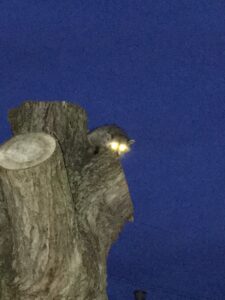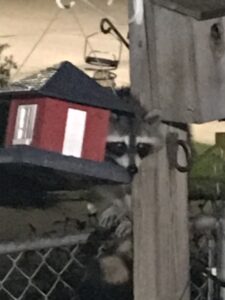
Raccoons are strong and hungry.
A raccoon kerfluffle with loud growling and snarling startled us to nearly jump from our chairs one May evening. It came from an oak tree 20 feet away from the house and close to our bird feeder. A flashlight beam on that pitch-black night revealed the culprits – three young raccoons high in the tree.
They quickly scurried down the tree and scampered out of flashlight range, letting us return to reading. Why was there a young raccoon kerfluffle? We can only guess but we’re certain they were there because of our nearby bird feeder.
What Raccoons Eat
At first glance, raccoons seem to be carnivores. They have sharp meat-eating teeth and look somewhat like a cross between a dog and a cat. Looks are deceiving. Raccoons are amazingly abundant across much of North America, in large part because they are opportunistic omnivores that seem eager to eat almost anything. They love frogs, crayfish, mussels, earthworms, fish, and any unfortunate mouse or vole they can catch. To a raccoon, a garbage can or dumpster is an invitation to dinner where they might discover delicious pizza crusts and an array of other discarded goodies.
Not Just Birds at the Feeder
Raccoons love fruit and grains. We have them in abundance. That is what lured them to our yard. To these cute but powerful animals, a feeder is an after-dark cafe. Most everyone is familiar with the determination squirrels show when attempting to reach even the most inaccessible feeder. Squirrels work feeders on the day shift while raccoons, deer, mice, voles,
skunks, opossums, bears, and flying squirrels often visit after dark when few people are watching.

Raccoons are skillful climbers.
At Winding Pathways, we put expensive sunflower seeds in a feeder suspended by a metal hook on a slippery metal pole. It is so high even deer can’t reach it. But since many birds prefer feeding on the ground, we sprinkle cracked corn, millet, and a few sunflower seeds on the ground beneath the high feeder.
Usually, birds clean up all the seeds by sunset, but frequently some remain as darkness approaches. It’s always gone the next morning. Nocturnal mammals did the clean-up work.
After Dark Feeder Watching
Once in a while, we focus a flashlight beam on the feeder after dark. Often the eyes of deer glow back at us, and occasionally we spot other animals enjoying a seed dinner. Usually visiting raccoons eat quietly, but the startling noise we heard that night came from squabbling youngsters.
Adaptable Raccoons
Raccoons are amazingly adaptable. Our son lives in one of the most densely populated cities in the world – Brooklyn, NY. He occasionally sees a raccoon sticking its head up from a dumpster.
They are not just in North America. Raccoons were introduced to Russia to create a fur resource. They also were released in 1934 in Germany and have since spread far and wide and are increasingly common in Ukraine. Many Japanese people imported baby raccoons as pets and released some as they grew large and unruly. Today wild raccoons range through much of that Asian country.
Whether in Russia, Ukraine, or Japan they are exotic, invasive animals causing mischief. Although common in the United States they are native here and sometimes create a mess as they paw through a trash can or raid a chicken coop. However, they’re fascinating and beautiful animals that can often be spotted beneath a feeder in a flashlight beam.
The Nature Conservancy posts an excellent blog called “Seven US Species Invading Other Countries.” Raccoons top the list.
Nightly Adventure Continues
Since that evening, the trio of masked bandits that caused a raccoon kerfuffle have returned. Sometimes, like any siblings, they get along. Other times they disturb the night as they screech, snarl, and growl at each other until we shine a light on them or shoo them off. We can always count on some nocturnal adventure at Winding Pathways.


And the ones I’ve run into are bold! Yeats ago, I turned a light on one , he looked at me and went back to trying to get the lid off my trash can!